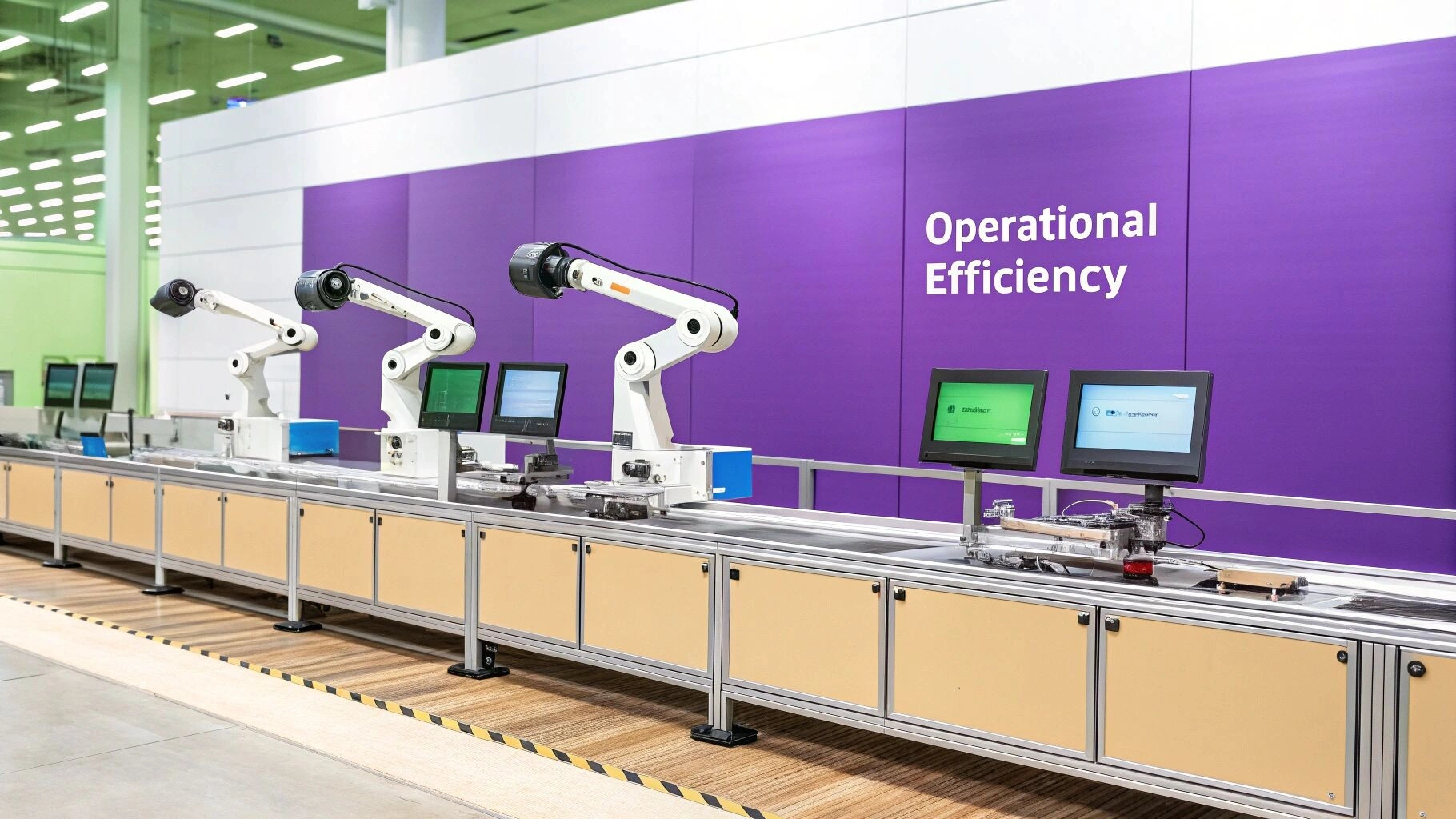9 Key Benefits of Business Automation in 2025
Discover the top benefits of business automation, from cost reduction to enhanced efficiency. See how AI can transform your Australian business today.

In a fiercely competitive market, operational agility and strategic resource allocation are critical. The pursuit of these goals is no longer a matter of incremental improvements but requires a fundamental shift in how work is performed. This is where the strategic implementation of business process automation becomes a critical differentiator, moving beyond a simple technological upgrade to become a core component of modern business strategy. By systematising repetitive tasks and integrating intelligent systems, organisations can unlock significant gains in productivity, accuracy, and overall performance.
This comprehensive guide delves into the most impactful benefits of business automation. We will provide a detailed exploration of nine key advantages, moving beyond surface-level observations to offer actionable insights and practical examples. You will learn precisely how automation can:
- Drastically reduce operational costs and reallocate human capital to higher-value activities.
- Enhance data integrity, leading to more reliable analytics and informed decision-making.
- Improve employee satisfaction by eliminating tedious, manual labour.
- Create a foundation for scalable growth and robust risk management.
Each point is designed to provide a clear roadmap for IT directors, operations managers, and C-level executives aiming to modernise workflows and secure a lasting competitive advantage. We will examine how these benefits materialise in real-world scenarios, helping you build a compelling business case for transformation.
1. Increased Operational Efficiency
One of the most profound benefits of business automation is the radical improvement in operational efficiency. By delegating manual, repetitive tasks to automated systems, organisations can streamline workflows, significantly reduce process completion times, and enhance accuracy. This transformation frees up valuable human resources from mundane administrative duties, allowing them to focus on strategic, high-value activities that drive innovation and growth.

Automation enables core business functions, from data entry and invoicing to customer onboarding, to operate continuously. These systems work 24/7 without fatigue or human error, eliminating bottlenecks and optimising resource allocation for maximum output.
How to Implement for Greater Efficiency
To successfully leverage automation, a strategic approach is essential. Start by identifying the most time-consuming and error-prone manual processes within your organisation.
- Map Existing Workflows: Before implementing any new tool, thoroughly document your current processes. This reveals inefficiencies and highlights the exact points where automation will deliver the greatest impact.
- Start Small and Scale: Begin with a pilot project in a single department, such as automating lead qualification in sales or invoice processing in finance.
- Monitor Key Metrics: Track specific Key Performance Indicators (KPIs) like processing time, error rate, and employee time saved to quantify the return on investment.
- Integrate Across Departments: Once a pilot is successful, gradually scale the automation solutions across other departments to create a cohesive, efficient operational ecosystem. Even small businesses can see immense benefits; for example, you can boost business growth with marketing automation by streamlining customer communication and campaign management.
Real-World Success Stories
Pioneers like Amazon have famously used warehouse automation to reduce order fulfilment times, while Toyota’s lean manufacturing principles rely heavily on automated systems to maintain quality and speed. These examples show how embedding automation into core operations isn’t just about cutting costs; it’s about building a more resilient and productive enterprise.
2. Significant Cost Reduction
Another of the core benefits of business automation is its direct impact on an organisation’s bottom line through significant cost reduction. By automating rule-based, high-volume tasks, businesses can dramatically lower labour costs associated with manual work. Furthermore, automation minimises costly human errors, such as incorrect data entry or compliance oversights, that often lead to financial penalties, rework, and wasted resources.

This strategic shift not only reduces direct operational expenses but also optimises resource allocation. Automated systems can manage inventory, process invoices, or handle customer service enquiries around the clock, ensuring that resources are utilised to their maximum potential without incurring overtime costs or expanding headcount unnecessarily.
How to Implement for Cost Savings
Achieving a measurable return on investment (ROI) from automation requires a deliberate and analytical approach. Start by targeting areas where automation can deliver the most substantial financial impact.
- Calculate ROI Beforehand: Analyse the potential savings in labour, error reduction, and resource optimisation against the cost of the automation software and its implementation. This ensures you prioritise projects with the best financial outcomes.
- Focus on High-Volume Tasks: Begin with processes that are repetitive and occur frequently, such as accounts payable or data verification. These “quick wins” demonstrate immediate cost savings and build momentum for larger initiatives.
- Consider Cloud-Based Solutions: SaaS automation platforms often have lower upfront costs compared to on-premise systems, reducing the initial capital expenditure and making automation more accessible.
- Track Savings with Analytics: Implement dashboards and reporting to continuously monitor metrics like cost-per-transaction, error rates, and employee hours saved. Use this data to justify further investment and refine your strategy.
Real-World Success Stories
Leading global corporations have demonstrated the immense cost-saving power of automation. JPMorgan Chase, for example, implemented its COIN system to analyse complex legal documents, saving an estimated 360,000 hours of manual work annually. Similarly, Walmart’s supply chain automation has helped reduce inventory carrying costs, while General Electric uses predictive maintenance automation to cut its machinery upkeep expenses by up to 25%, preventing costly downtime. These examples highlight how automation is a powerful lever for achieving financial efficiency and a stronger competitive edge.
3. Enhanced Accuracy and Error Reduction
Another significant advantage derived from the benefits of business automation is the dramatic improvement in data accuracy. Automated systems are engineered to perform tasks with unwavering precision, following predefined rules without deviation. This systematic approach effectively eliminates the human errors inherent in manual processes, which can be costly and time-consuming to rectify, especially in data-sensitive fields where accuracy is paramount for compliance and strategic decision-making.

By removing the risk of typos, miscalculations, or procedural oversights, organisations can foster greater trust in their data. This heightened accuracy ensures that financial reports, customer records, and operational analytics are reliable, providing a solid foundation for informed business intelligence and maintaining regulatory integrity.
How to Implement for Greater Accuracy
Achieving enhanced accuracy requires a deliberate and thoughtful implementation strategy. It’s not just about deploying a tool but about building a reliable, error-resistant process from the ground up.
- Implement Robust Testing: Before a full-scale deployment, rigorously test the automation in a controlled environment. Simulate various scenarios to identify and resolve potential failure points.
- Create Validation Checkpoints: Design automated workflows with built-in validation steps. These checkpoints can cross-reference data or flag anomalies for human review, preventing errors from propagating.
- Maintain Detailed Audit Trails: Ensure your automated systems log all actions. These audit trails are crucial for accountability, troubleshooting, and demonstrating compliance during an audit.
- Regularly Update Automation Rules: Business needs and regulations change. Periodically review and update your automation logic to ensure it remains accurate and relevant. You can discover more about this process and automate data entry tasks on osher.com.au to minimise manual input errors.
Real-World Success Stories
Leaders across various industries showcase the power of automation in boosting accuracy. Aetna, a major health insurance provider, reduced claims processing errors by an estimated 90% through automation. Similarly, Bank of America improved its loan processing accuracy to 99.5% with automated systems. In logistics, FedEx has achieved a remarkable 99.9% accuracy in package routing by relying on sophisticated automated sorting systems, proving that automation is essential for operational excellence.
4. Improved Employee Satisfaction and Productivity
Beyond optimising processes, one of the most significant benefits of business automation is its positive impact on the human workforce. By automating mundane, repetitive tasks, organisations empower employees to shift their focus from tedious manual work to more strategic, creative, and fulfilling responsibilities. This fundamental change in daily work not only boosts job satisfaction but also enhances productivity by aligning human talent with high-value activities that drive innovation.

When employees are engaged in meaningful work that utilises their unique skills, their morale and loyalty increase, leading to better retention rates. Automation acts as a digital assistant, handling the administrative burden and freeing up mental capacity for complex problem-solving, strategic planning, and building deeper customer relationships.
How to Implement for Greater Satisfaction
To ensure automation enhances the employee experience, it must be introduced thoughtfully and with clear communication. The goal is to augment human capabilities, not replace them.
- Involve Employees in Planning: Engage your team in identifying which tasks are most suitable for automation. They often have the best insights into which processes are the most tedious and time-consuming.
- Provide Robust Training: Equip staff with the necessary skills to work alongside new automated systems and transition into higher-value roles. This investment shows a commitment to their growth.
- Communicate Benefits Clearly: Proactively address concerns by highlighting how automation will improve their work-life, reduce burnout, and create opportunities for professional development. Successful implementation requires understanding how to manage the human side of change, and you can learn more about overcoming employee resistance to automation to ensure a smooth transition.
- Transition Gradually: Introduce automation in phases rather than all at once. This approach allows employees to adapt to new workflows without feeling overwhelmed.
Real-World Success Stories
Tech giants like Google and Microsoft have championed this approach by developing and using workflow automation tools that reduce administrative overhead for their teams. Similarly, Slack uses automation to handle routine customer support queries, freeing its agents to tackle more complex issues that require critical thinking and human empathy, thereby improving both customer and employee satisfaction.
5. Better Customer Experience and Service
Enhancing the customer experience is a critical benefit of business automation, transforming how organisations interact with their clientele. By automating routine customer service functions, businesses can deliver faster response times, maintain consistent service quality, and offer 24/7 availability. This ensures that customers receive immediate support for common inquiries, significantly boosting satisfaction and loyalty.
Automated systems like chatbots and AI-powered helpdesks can instantly handle a high volume of routine queries, from order tracking to basic troubleshooting. This frees up human support agents to focus their expertise on resolving more complex or sensitive issues, adding a valuable human touch where it matters most.
How to Implement for a Better Customer Experience
A strategic approach is necessary to ensure automation genuinely improves the customer journey rather than creating a frustrating, robotic experience.
- Personalise Automated Interactions: Leverage customer data to tailor automated communications. Using a customer’s name, purchase history, or known preferences can make interactions feel more personal and relevant.
- Maintain Human Escalation Paths: Always provide a clear and easy way for customers to connect with a human agent. This is crucial for complex problems or when a customer simply prefers human interaction, preventing frustration.
- Monitor Customer Satisfaction Metrics: Closely track Key Performance Indicators (KPIs) like Customer Satisfaction (CSAT) scores, Net Promoter Score (NPS), and first-contact resolution rates to measure the impact of your automation.
- Continuously Improve Based on Feedback: Use customer feedback and interaction data to refine and improve your automated systems. Analyse chatbot conversation logs to identify common issues and update responses accordingly.
Real-World Success Stories
Leading companies demonstrate how automation can revolutionise customer service. Sephora’s AI-powered chatbot successfully handles a large percentage of initial customer inquiries, offering instant beauty advice and order support. Similarly, Uber’s automated ride-matching and support system provides near-instantaneous responses and resolutions for common trip issues, setting a high standard for on-demand service. These examples show that well-implemented automation is a cornerstone of modern, customer-centric operations.
6. Enhanced Data Management and Analytics
One of the most transformative benefits of business automation lies in its ability to enhance data management and analytics. Automated systems are purpose-built to collect, process, and analyse vast quantities of data with speed and precision, turning raw information into a strategic asset. This capability provides organisations with real-time, actionable insights that empower more intelligent and timely decision-making.
By automating data collection, businesses ensure consistency and eliminate the human errors inherent in manual entry. This creates a high-quality data foundation, allowing advanced analytics tools to uncover trends, patterns, and correlations that would otherwise remain hidden. Ultimately, this transforms data from a passive record into a dynamic driver of strategy and competitive advantage.
How to Implement for Better Insights
To effectively harness automation for data analytics, a structured and deliberate approach is crucial. The goal is to build a system that delivers clear, relevant, and actionable intelligence.
- Define Clear Metrics: Before you begin, identify the Key Performance Indicators (KPIs) that are most critical to your business objectives. This ensures your automation efforts are focused on gathering and analysing data that truly matters.
- Ensure Data Quality: Implement automated validation rules and data cleansing processes to maintain the integrity and consistency of your data. High-quality input is essential for reliable analytical output.
- Create Visual Dashboards: Utilise business intelligence (BI) tools to create intuitive dashboards. Visualising data helps key stakeholders quickly grasp complex information and spot trends at a glance.
- Train Staff on Interpretation: Equip your teams with the skills to not just read data, but to interpret it correctly and translate insights into strategic actions.
Real-World Success Stories
Leading companies demonstrate the power of automated analytics. Netflix famously analyses viewer data to inform its content acquisition and production strategies, ensuring its investments align with audience preferences. Similarly, Salesforce automates the collection and organisation of customer data within its CRM, providing sales teams with a 360-degree view of every client interaction and opportunity. These examples prove that robust, automated data management is central to a modern, data-driven enterprise.
7. Improved Scalability and Growth Support
A critical benefit of business automation is its ability to support and accelerate growth by enabling seamless scalability. Automated systems can manage a substantially increased workload, such as a surge in customer orders or data processing, without requiring a proportional increase in human resources or operational costs. This decoupling of growth from resource expenditure is fundamental for businesses aiming to expand their market presence efficiently.
This capability ensures that operational capacity is not a bottleneck to expansion. As your business grows, automated workflows can scale on demand, processing higher volumes of transactions, interactions, and data with consistent performance and accuracy. This allows organisations to seize market opportunities without being constrained by legacy manual processes that are slow and expensive to scale.
How to Implement for Greater Scalability
To ensure automation effectively supports growth, a forward-thinking strategy is crucial. The goal is to build systems that are robust enough for today and flexible enough for tomorrow.
- Design for Future Growth: When selecting and configuring automation tools, don’t just solve for your current volume. Architect systems with future capacity in mind, choosing platforms known for their scalability.
- Monitor System Performance: As your business scales, closely track key performance indicators (KPIs) like system response time, transaction throughput, and error rates under increasing loads. This helps identify potential bottlenecks before they impact operations.
- Implement Redundancy: Build redundancy and load balancing into your automated systems to ensure high availability and prevent single points of failure, especially during periods of rapid growth or peak demand.
- Plan for Gradual Scaling: A phased approach to scaling is often more manageable than a sudden, large-scale expansion. This allows you to test system limits and make adjustments iteratively. You can explore a range of effective business growth strategies on osher.com.au to align your operational capacity with your strategic goals.
Real-World Success Stories
Leaders in scalability demonstrate the power of automation. Shopify’s automated e-commerce platform empowers over a million merchants by handling everything from storefront creation to payment processing, scaling effortlessly with each merchant’s success. Similarly, Zoom scaled its automated infrastructure to support 300 million daily users during the pandemic, a feat impossible without a highly scalable, automated foundation.
8. Enhanced Compliance and Risk Management
Navigating the complex web of industry regulations and internal policies is a critical challenge, and automation provides a powerful solution for enhancing compliance and mitigating risk. By embedding rule-based logic into automated systems, organisations can ensure processes are executed consistently and in strict adherence to legal and corporate standards. This standardisation eliminates the variability and potential for human error inherent in manual execution, a crucial advantage in highly regulated sectors.
Automated systems create immutable, time-stamped audit trails for every action, providing transparent and easily accessible records for internal reviews or external audits. This robust documentation simplifies the process of demonstrating compliance, significantly reducing the risks of fines, legal action, and reputational damage associated with non-compliance. These benefits of business automation are indispensable for maintaining corporate integrity.
How to Implement for Better Compliance
A proactive and structured approach is vital for leveraging automation to manage compliance and risk effectively. The goal is to build a resilient framework that adapts to evolving regulations.
- Implement Comprehensive Logging: Ensure all automated systems create detailed logs of their activities. These records are your primary evidence of compliance and are essential for forensic analysis if a breach occurs.
- Stay Updated on Regulatory Changes: Use automated alert systems or specialised software to monitor changes in relevant regulations (like GDPR, HIPAA, or financial reporting standards). This allows you to update your automated workflows proactively.
- Conduct Regular Audits: Routinely audit your automated systems to verify they are functioning as intended and remain aligned with current compliance requirements. These audits should test the system’s logic and outputs.
- Train Staff on Procedures: Ensure employees understand how the automated compliance systems work and are trained on the proper procedures for escalating exceptions or system-flagged issues.
Real-World Success Stories
Leaders in heavily regulated industries demonstrate the power of compliance automation. Goldman Sachs famously implemented automated trading compliance checks, reportedly reducing regulatory violations by 85%. Similarly, HSBC relies on sophisticated anti-money laundering (AML) systems to automatically screen millions of daily transactions for suspicious activity. In healthcare, providers like Kaiser Permanente use automated workflows to enforce HIPAA rules, protecting patient data and avoiding costly breaches.
9. Competitive Advantage and Market Leadership
Beyond internal efficiencies, one of the most powerful benefits of business automation is its capacity to forge a significant competitive advantage and establish market leadership. By automating core processes, organisations can accelerate their time-to-market, optimise resource allocation with unparalleled precision, and deliver superior products and services. This strategic deployment of automation moves a company beyond simply competing on price, positioning it as an industry innovator and leader.
Automation creates a foundation for strategic differentiation that is difficult for competitors to replicate. When embedded deeply into manufacturing, service delivery, or customer experience, it builds a protective moat around the business, allowing for sustained growth and profitability.
How to Implement for Market Leadership
Achieving a competitive edge through automation requires a strategic, forward-thinking approach that focuses on creating unique value.
- Identify Your Differentiators: Pinpoint the areas where your business can uniquely excel. Is it speed, quality, cost, or customer personalisation? Focus your automation efforts there to amplify your strengths.
- Build Difficult-to-Replicate Systems: Avoid off-the-shelf solutions for your core competitive processes. Instead, develop or customise automation capabilities that are unique to your operational model and strategic goals.
- Leverage Data for Strategic Insight: Use automation to not only perform tasks but also to collect and analyse data. This provides insights that fuel continuous improvement and inform strategic decisions, keeping you ahead of the market.
- Innovate Relentlessly: Treat your automated systems as dynamic assets that require constant refinement. Continuously explore new technologies and methods to enhance your automated processes and maintain your lead.
Real-World Success Stories
Titans of industry demonstrate how automation builds market dominance. Tesla’s highly automated “gigafactories” have revolutionised electric vehicle manufacturing, giving them a significant cost and production advantage. Similarly, Amazon’s comprehensive automation ecosystem, from its warehouses to its AWS cloud services, has created an almost insurmountable competitive barrier in e-commerce and web infrastructure. These examples highlight how strategic automation is a key driver of modern market leadership.
Benefits Comparison Matrix of 9 Key Automation Areas
| Aspect | Increased Operational Efficiency | Significant Cost Reduction | Enhanced Accuracy and Error Reduction | Improved Employee Satisfaction and Productivity | Better Customer Experience and Service | Enhanced Data Management and Analytics | Improved Scalability and Growth Support | Enhanced Compliance and Risk Management | Competitive Advantage and Market Leadership |
|---|---|---|---|---|---|---|---|---|---|
| Implementation Complexity | Moderate; requires workflow mapping and setup | High; involves heavy initial investment | High; needs careful setup and robust testing | Moderate; needs change management and training | Moderate; requires sophisticated AI and escalation | High; demands significant data infrastructure | High; must plan for future growth and upgrades | High; involves complex regulatory requirements | High; demands significant investment and commitment |
| Resource Requirements | Automation tools, ongoing maintenance | Capital investment, licensing, maintenance | Skilled setup team, validation tools | Training programs, change management resources | AI/chatbot technology, customer data | Data infrastructure, analytics tools, skilled analysts | Scalable infrastructure, load balancing tech | Compliance tools, audit systems, continual updates | Advanced automation tech, continuous innovation efforts |
| Expected Outcomes | Faster processes, reduced bottlenecks | Lower operational and labor costs | Near-zero errors, consistent quality | Higher job satisfaction, increased innovation | 24/7 support, faster responses, consistent service | Real-time insights, improved decision-making | Seamless scaling, cost-effective growth | Reduced violations, consistent compliance | Market leadership, superior operational performance |
| Ideal Use Cases | Repetitive workflows, manufacturing | High-volume, low-complexity tasks | Data-sensitive industries, compliance-critical areas | Knowledge work, creative roles | Customer service, support centers | Data-heavy operations, business intelligence | Rapidly growing businesses, variable workloads | Regulated industries, risk-sensitive sectors | Industry leaders seeking innovation and differentiation |
| Key Advantages | 24/7 operations, reduced manual effort | Quick ROI, waste reduction | Improved compliance, reduced rework | Reduced burnout, skill development | Improved satisfaction, reduced wait times | Faster insights, predictive analytics | Cost-effective expansion, consistent performance | Simplified reporting, better risk management | First-mover advantage, enhanced agility |
Your Next Step Towards an Automated Future
The journey through the core benefits of business automation reveals a clear and compelling narrative: automation is not merely a technological upgrade but a fundamental strategic shift. We have explored how it systematically dismantles operational bottlenecks, drives significant cost reductions, and dramatically enhances accuracy by minimising human error. The ripple effect of these efficiencies is profound, extending far beyond the balance sheet.
By automating repetitive, low-value tasks, organisations can liberate their most valuable asset: their people. This leads to higher employee satisfaction, fosters a culture of innovation, and allows your team to focus on strategic, creative, and customer-facing work. The result is a superior customer experience, underpinned by faster responses, personalised interactions, and consistent service delivery. The advantages don’t stop there; automation provides the robust framework for enhanced data management, superior analytics, and airtight compliance, positioning your business for sustainable scalability and market leadership.
From Theory to Tangible Results
The critical takeaway is that the benefits of business automation are interconnected, creating a powerful cycle of continuous improvement.
- Efficiency breeds growth: Streamlined operations allow you to scale without a proportional increase in overheads.
- Data drives decisions: Automated data collection and analysis provide the clear insights needed for confident, strategic planning.
- Empowered employees innovate: When freed from mundane tasks, your team can better serve customers and identify new opportunities, cementing your competitive advantage.
Viewing automation through this holistic lens is crucial. It’s not about replacing humans but augmenting their capabilities, creating a more resilient, agile, and intelligent organisation. The initial investment in automation technology quickly transforms into a long-term competitive moat, safeguarding your market position and fuelling future growth initiatives.
Charting Your Automation Course
Embarking on this transformative path requires careful planning and strategic execution. The first step is to conduct a thorough audit of your current workflows. Identify the most time-consuming, error-prone, and repetitive processes within departments like finance, HR, marketing, and operations. These are your prime candidates for initial automation projects.
Consider starting with a pilot program. Select a single, high-impact process, such as invoice processing or customer onboarding, to automate. This allows you to measure the ROI, gather learnings, and build internal momentum before a broader rollout. Engaging a specialist partner can be instrumental in this phase, providing the expertise to navigate technology selection, integration, and change management. By taking a deliberate, phased approach, you can ensure that your automation strategy delivers measurable value at every stage, turning the immense potential we’ve discussed into your new business reality.
Ready to translate these benefits into a tailored strategy for your organisation? The expert team at Osher Digital specialises in designing and implementing bespoke business process automation and AI-driven solutions. Visit Osher Digital to discover how we can help you navigate your automation journey and unlock your business’s full potential.
Jump to a section
Ready to streamline your operations?
Get in touch for a free consultation to see how we can streamline your operations and increase your productivity.